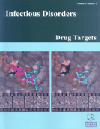- Home
- A-Z Publications
- Infectious Disorders - Drug Targets (Formerly Current Drug Targets - Infectious Disorders)
- Previous Issues
- Volume 13, Issue 1, 2013
Infectious Disorders - Drug Targets (Formerly Current Drug Targets - Infectious Disorders) - Volume 13, Issue 1, 2013
Volume 13, Issue 1, 2013
-
-
Oseltamivir Pharmacology in Young Children: A Commentary
More LessOseltamivir is listed by the World Health Organization as an essential drug for the treatment and prophylaxis of both seasonal and pandemic influenza. Since influenza mortality is highest in neonates and infants, optimal dosing of oseltamivir in this high risk population is of utmost public health concern. To date, only two major clinical trials have been conducted investigating oselatmivir exposure and exposure/response in Read More
-
-
-
Pharmacokinetics and Pharmacodynamics of Oseltamivir in Neonates, Infants and Children
More LessAuthors: Joseph F. Standing, Maria Tsolia and Irja LutsarPharmacokinetic-pharmacodynamic (PKPD) studies have the potential to yield useful information on whether and how a drug works, and what dose to use. This approach is often best suited to situations where dose-response relationships need to be elucidated and where randomisation is not feasible. Children make up around one third of cases during influenza outbreaks, and are more susceptible to certain complications such Read More
-
-
-
Oseltamivir in Neonates, Infants and Young Children: A Focus on Clinical Pharmacology
More LessAuthors: Eda Karadag-Oncel and Mehmet CeyhanInfluenza is a cause of significant morbidity and mortality in young children. It is associated with high annual attack rates as well as being responsible for frequent outpatient visits and hospitalisations. Children aged <2 years are at the highest risk for serious illness or death during the influenza season. The neuraminidase inhibitor oseltamivir has been proven to reduce the duration and severity of illness when treatmen Read More
-
-
-
Towards a Personalised Approach to Managing Influenza Infections in Infants and Children – Food for Thought and a Note on Oseltamivir
More LessAcute respiratory infections represent common diseases in childhood and a challenge to infection control, public heath, and the clinical management of patients and their families. Children are avid spreaders of respiratory viruses, and seasonal outbreaks of influenza create additional disease burden and healthcare cost. Infants under the age of two and children with chronic conditions are at high risk. The ab Read More
-
-
-
Emergence of Oseltamivir Resistance: Control and Management of Influenza before, during and after the Pandemic
More LessAuthors: Rashmi Dixit, Gulam Khandaker, Scott Ilgoutz, Harunor Rashid and Robert BooyNeuraminidase inhibitors (NAIs), such as oseltamivir and zanamivir, are the medicines of choice against influenza A or B. Oseltamivir resistance can be conferred by a single point missense mutation from histidine to tyrosine at position 275 (H275Y) of the neuraminidase gene. Oseltamivir resistance in seasonal influenza A/H1N1 strains rose markedly during the 2007-2008 season. Furthermore, oseltamivir resistant (OsR) str Read More
-
-
-
Oseltamivir Use in Adolescents and Adults: Clinical and Economic Considerations
More LessAuthors: J. K. Yin, Leon Heron, Glenn Salkeld, Harunor Rashid and Robert BooyInfluenza remains an important cause of morbidity and mortality, and incurs substantial economic costs (mainly due to hospitalisation) especially for the elderly aged 65 years or more, and among those with high-risk medical conditions. Influenza vaccination is the most effective control measure for both healthy populations and the chronically ill in whom complications of influenza cluster. Unfortunately, vaccination is less Read More
-
-
-
Inflammation Theories in Psychotic Disorders: A Critical Review
More LessAuthors: Jaana Suvisaari and Outi MantereRecent research suggests that inflammation and immunity may have a role in the etiology of psychotic disorders. There is evidence of proinflammatory activation of the innate immune system and an activation of the T-cells of the adaptive immune system in both schizophrenia and bipolar disorder. Studies of antipsychotic-naive patients with firstepisode psychosis have found that inflammation is present already at th Read More
-
-
-
Post Marketing Surveillance on Safety and Efficacy of IMOD in Iranian Patients with HIV/AIDS
More LessAcquired Immune Deficiency Syndrome is one of the world's serious health problems. Immune-based therapy is a new approach in the treatment of HIV infected patients. IMODTM with the ability to correct immune deficiencies has been introduced for the management of HIV infection. In the phase IV trial study the main objectives were to assess the possible side effects, evaluate its effect on CD4+ T Lymphocyte count and pa Read More
-
-
-
Proresolution Mediators and Receptors: Novel Drug Targets for Enhancing Pharmacological Armamentarium against Periodontal Inflammation
More LessAuthors: Vishakha Grover, Ranjan Malhotra, Anoop Kapoor, Jasvinder Singh and Sonia SachdevaPeriodontal diseases are comprised of a group of inflammatory conditions that result in the destruction of the supporting structures of the dentition. Emphasis has traditionally been placed on the deleterious actions of lipid mediators, such as prostanoids and leukotrienes, in propagating the inflammatory response and enhancing tissue destruction. Recently, the emerging understanding of the molecular basis of inflammation Read More
-
Volumes & issues
-
Volume 25 (2025)
-
Volume 24 (2024)
-
Volume 23 (2023)
-
Volume 22 (2022)
-
Volume 21 (2021)
-
Volume 20 (2020)
-
Volume 19 (2019)
-
Volume 18 (2018)
-
Volume 17 (2017)
-
Volume 16 (2016)
-
Volume 15 (2015)
-
Volume 14 (2014)
-
Volume 13 (2013)
-
Volume 12 (2012)
-
Volume 11 (2011)
-
Volume 10 (2010)
-
Volume 9 (2009)
-
Volume 8 (2008)
-
Volume 7 (2007)
-
Volume 6 (2006)
Most Read This Month
Article
content/journals/iddt
Journal
10
5
false
en


